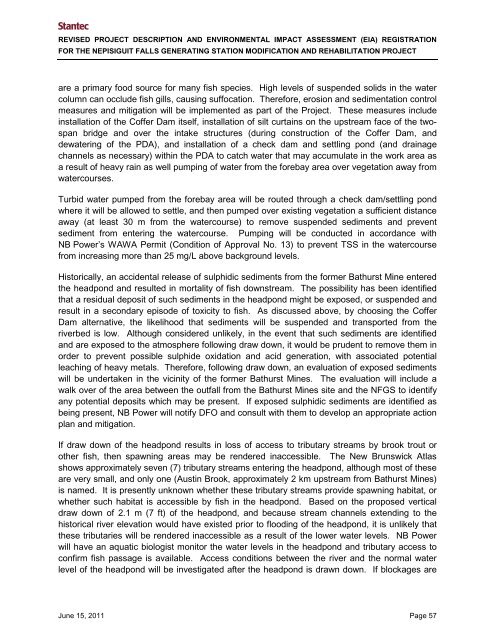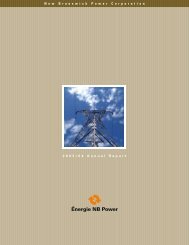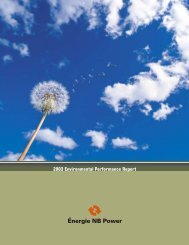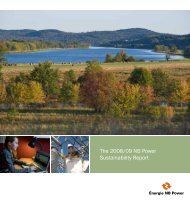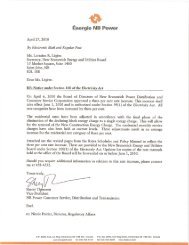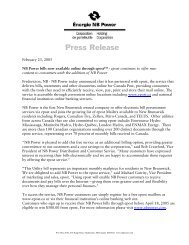Environmental Impact Assessment(EIA) Registration for the ...
Environmental Impact Assessment(EIA) Registration for the ...
Environmental Impact Assessment(EIA) Registration for the ...
Create successful ePaper yourself
Turn your PDF publications into a flip-book with our unique Google optimized e-Paper software.
REVISED PROJECT DESCRIPTION AND ENVIRONMENTAL IMPACT ASSESSMENT (<strong>EIA</strong>) REGISTRATION<br />
FOR THE NEPISIGUIT FALLS GENERATING STATION MODIFICATION AND REHABILITATION PROJECT<br />
are a primary food source <strong>for</strong> many fish species. High levels of suspended solids in <strong>the</strong> water<br />
column can occlude fish gills, causing suffocation. There<strong>for</strong>e, erosion and sedimentation control<br />
measures and mitigation will be implemented as part of <strong>the</strong> Project. These measures include<br />
installation of <strong>the</strong> Coffer Dam itself, installation of silt curtains on <strong>the</strong> upstream face of <strong>the</strong> twospan<br />
bridge and over <strong>the</strong> intake structures (during construction of <strong>the</strong> Coffer Dam, and<br />
dewatering of <strong>the</strong> PDA), and installation of a check dam and settling pond (and drainage<br />
channels as necessary) within <strong>the</strong> PDA to catch water that may accumulate in <strong>the</strong> work area as<br />
a result of heavy rain as well pumping of water from <strong>the</strong> <strong>for</strong>ebay area over vegetation away from<br />
watercourses.<br />
Turbid water pumped from <strong>the</strong> <strong>for</strong>ebay area will be routed through a check dam/settling pond<br />
where it will be allowed to settle, and <strong>the</strong>n pumped over existing vegetation a sufficient distance<br />
away (at least 30 m from <strong>the</strong> watercourse) to remove suspended sediments and prevent<br />
sediment from entering <strong>the</strong> watercourse. Pumping will be conducted in accordance with<br />
NB Power’s WAWA Permit (Condition of Approval No. 13) to prevent TSS in <strong>the</strong> watercourse<br />
from increasing more than 25 mg/L above background levels.<br />
Historically, an accidental release of sulphidic sediments from <strong>the</strong> <strong>for</strong>mer Bathurst Mine entered<br />
<strong>the</strong> headpond and resulted in mortality of fish downstream. The possibility has been identified<br />
that a residual deposit of such sediments in <strong>the</strong> headpond might be exposed, or suspended and<br />
result in a secondary episode of toxicity to fish. As discussed above, by choosing <strong>the</strong> Coffer<br />
Dam alternative, <strong>the</strong> likelihood that sediments will be suspended and transported from <strong>the</strong><br />
riverbed is low. Although considered unlikely, in <strong>the</strong> event that such sediments are identified<br />
and are exposed to <strong>the</strong> atmosphere following draw down, it would be prudent to remove <strong>the</strong>m in<br />
order to prevent possible sulphide oxidation and acid generation, with associated potential<br />
leaching of heavy metals. There<strong>for</strong>e, following draw down, an evaluation of exposed sediments<br />
will be undertaken in <strong>the</strong> vicinity of <strong>the</strong> <strong>for</strong>mer Bathurst Mines. The evaluation will include a<br />
walk over of <strong>the</strong> area between <strong>the</strong> outfall from <strong>the</strong> Bathurst Mines site and <strong>the</strong> NFGS to identify<br />
any potential deposits which may be present. If exposed sulphidic sediments are identified as<br />
being present, NB Power will notify DFO and consult with <strong>the</strong>m to develop an appropriate action<br />
plan and mitigation.<br />
If draw down of <strong>the</strong> headpond results in loss of access to tributary streams by brook trout or<br />
o<strong>the</strong>r fish, <strong>the</strong>n spawning areas may be rendered inaccessible. The New Brunswick Atlas<br />
shows approximately seven (7) tributary streams entering <strong>the</strong> headpond, although most of <strong>the</strong>se<br />
are very small, and only one (Austin Brook, approximately 2 km upstream from Bathurst Mines)<br />
is named. It is presently unknown whe<strong>the</strong>r <strong>the</strong>se tributary streams provide spawning habitat, or<br />
whe<strong>the</strong>r such habitat is accessible by fish in <strong>the</strong> headpond. Based on <strong>the</strong> proposed vertical<br />
draw down of 2.1 m (7 ft) of <strong>the</strong> headpond, and because stream channels extending to <strong>the</strong><br />
historical river elevation would have existed prior to flooding of <strong>the</strong> headpond, it is unlikely that<br />
<strong>the</strong>se tributaries will be rendered inaccessible as a result of <strong>the</strong> lower water levels. NB Power<br />
will have an aquatic biologist monitor <strong>the</strong> water levels in <strong>the</strong> headpond and tributary access to<br />
confirm fish passage is available. Access conditions between <strong>the</strong> river and <strong>the</strong> normal water<br />
level of <strong>the</strong> headpond will be investigated after <strong>the</strong> headpond is drawn down. If blockages are<br />
June 15, 2011 Page 57


